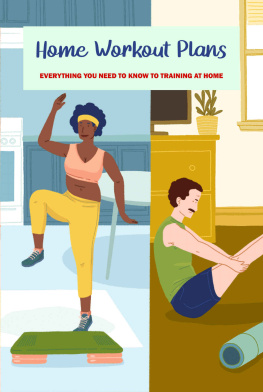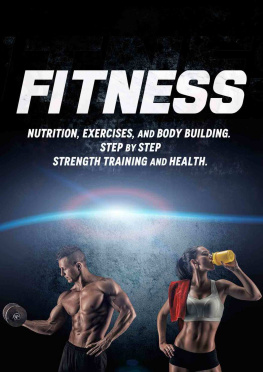John McDillon
WEIGHT
TRAINING
FOR BEGINNERS
A Complete Illustrated Guide to Strength Training at Home for Men and Women. Easy and Effective Exercises and Workouts with Free Weights to Burn Fat and Build Muscle
Copyright 2020 publishing.
All rights reserved.
Author: John McDillon
No part of this publication may be reproduced, distributed or transmitted in any form or by any means, including photocopying recording or other electronic or mechanical methods or by any information storage and retrieval system without the prior written permission of the publisher, except in the case of brief quotation embodies in critical reviews and certain other non-commercial uses permitted by copyright law.
I am strong
Im fit
Ill make it
My determination is firm
Table of Contents
INTRODUCTION
The goal of this program is to help you achieve a better fit, lose weight and develop the necessary fitness and cardiovascular basis you need to achieve your goals. Follow-up programs are available, and you can prepare for your next level of fitness. However, if you train with this e-book, you have to achieve two goals.
- Build a fitness base
- Lose weight
DO YOU HAVE TIME TO EXERCISE?
Do you not have enough time to exercise on your day? Too many people say, I have to exercise, but I dont have enough time for the day. Or if you have the time, you have the energy to lie down and watch TV. Whether youre on business, working at home, working with family, or holding other post-school events, the following schedule or a version of it can help you overcome your problems.
Exercise is more than sleeping or sitting. You can use abdominal exercises to move your upper body or other upper body exercises, even if your back or abdomen is on a flat floor. Pushups are a great lying exercise, and abdominal cramps are a little more complicated than sleeping. An hour a day is an admirable goal to improve your fitness level and overall health, but even 10-15 minutes are more effective than nothing.
Getting fit in one day is a challenge that we all have to face. Exercising after long hours at home, in the office, or on the street is difficult, but it still creates a generation of people with obesity and other preventable health problems, so Americans still have to exercise. Many people who have difficulty keeping their fitness on schedule can get their work done 15 to 20 minutes before the start of the day and 15 to 20 minutes after the end of the day. Im going. Even if the exercise is a simple walk before breakfast and after dinner, a 15 to 20-minute walk at any of these times can help significantly burn calories that only accumulate as fat. An easy walk and some gymnastics after a meal can help increase your energy levels and help you do everything.
HERE IS THE SCHEDULE I USUALLY DO FOR BUSY DAYS WHEN A LONG DAY COMES:
- 06:00 - Get up early to do aerobic exercise such as running, cycling, or swimming for 20 to 30 minutes. When you're on the go, find the hotel pool and wake up for the day.
- 07:00 - Have breakfast for the energy of the day. (See Lean Down Food Plan)
- 08:00 - work
- Work-eat a snack
- 12:30 - eat lunch
- 1:15 - Walk a few minutes
- 1:30 - work
- 4:00 am - Work - Eat a snack
- 6:00 - break for dinner
- 7:00 - PT for walking or lifting weights or for a second wind on long days
- 8:00 - continue working until midnight if necessary
I want to do cardio training early in the morning when I have to work 15 to 18 hours. That woke me up completely, and I am ready to take care of the day before. Next, enjoy a delicious breakfast of protein, carbohydrates, and plenty of water. Then pack midnight snacks like apples, oranges, yoghurt, and nutritional bars. It will help you become a greedy canteen at lunch in the restaurant. For lunch, a green leafy salad with red meat like chicken, fish and boiled eggs. Then take a 10-15 minute walk to maintain your afternoon metabolism. If you put away bread, pure sugar and protein foods, complex carbohydrates and fibre, your afternoon work will be much easier. After the rest of the day, take a break for a mid-sized dinner and go again if you don't have weights, no short workouts, or these facilities. But a training session or PT gives us the second wind we need to work and play with our family. I hope these tips are helpful because they are common problems we see today. Remember that something is better than anything else. Go out and go at least several times a day.
FIVE PHASES OF FITNESS (PSYCHOLOGICAL)
Below are five phases we all experience when we start a new fitness program, regardless of what level of fitness we have.
- Make a decision to be healthy ... this takes 3-4 seconds, but it takes about 2-3 weeks to make a habit - stays there at least long ... and build a practice well on.
- You doubt yourself. It is natural to ask what you are trying to do. My advice is to challenge yourself and get over it as soon as possible. Understand that self-doubt is part of the process ... Even SEAL trainees challenge themselves, but those who become SEAL overcome their doubts.
- Overcome the suspicion - you can do anything you can imagine. You said that to yourself now. Here mind and body connect. Used to promote education in all areas of life, including work, relationships and school. I am convinced that by training your body, your stamina and energy can exercise your spirit and build a better relationship. Things around you ...
- Connect with a healthy and healthy person. Now adjust your mind and body. Your example will inspire others. It plays the role of model for other heavy people. People will be excited about your new work ethic, work and play. A healthy diet is still your habit ... When you eat grumpy foods, you feel a little sick.
- Set your own goals and conquer. Whatever you like - run, increase your bike weight ... challenge yourself, run 10 km, lift 400 pounds ...
AN ESSENTIAL GUIDE TO STRENGTH TRAINING
Basics and programs of strength training:
The basis for successful strength training is a combination of elements that are sometimes referred to as FITT.
- Training frequency - frequency
- Training intensity - how difficult it is
- Time spent - session time
- Exercise type - which exercise
- Muscle and exercise
- Understanding the muscles and how they work is vital for strength training.
- There are two types of muscle contraction.
- Isometric contraction: muscles do not stretch. An example of this is pushing a wall.
- Isotonic contractions: The muscles become shorter and more extended. The shortening phase is called "concentric: contraction" and the extension phase is called "eccentric" contraction.
For example, the curl of the barbell arm shortens the muscles (concentric circles) when you lift the barbell and lengthens (eccentricity) when you lower it. Eccentric contractions mainly cause muscle pain.
COMMON MOVEMENT
Muscle contraction is related to joint mobility. The four most critical collective actions are flexion and extension, abduction and adduction.
- Flexion is the reduction of joint angles. An example is an upward movement of the arms curvature that reduces the aspect of the elbow joint.
- Extension is the opposite movement. Increase the edge while reducing weight.
- Abduction is the removal of a body part from the centre of the side body. For example, raise your legs to the side of your body.
- The adduction brings part of the body closer to the midline of the body.
MUSCLE GROUP





